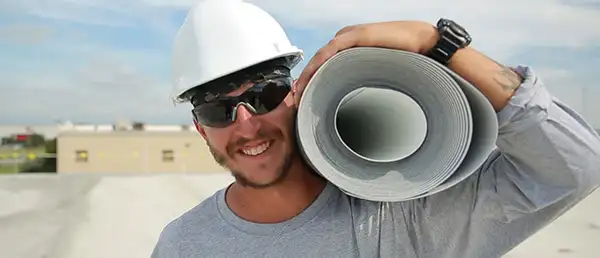#AskCentiMark: Let’s start from the top - the membrane - with Anne Serzz.

Hi, it’s Anne Serzz and I’m here to help you learn about the top layer of your commercial roof, the membrane! Your roof membrane is essential for safeguarding your building from outdoor elements, ensuring it’s watertight, enhancing energy efficiency and much more. Learning about the different types of commercial roof membranes on the market can help you make better roofing decisions that fit your facility’s needs.
Let’s dive into the three main types of membranes and their unique benefits:
Why Thermoplastic Polyolefin (TPO)?
TPO membranes have earned a strong reputation for their versatility and weatherability. Ever since the 1990s, they’ve been a popular choice in the low-slope roofing market due to their absence of plasticizers and chlorine, making them a wise choice for environmentally conscious businesses.
The materials in a TPO membrane are designed to combat challenges such as harsh weather, algae, debris build-up and more. Known for their low maintenance requirements, TPO membranes offer excellent long-term value in terms of total cost of ownership. From retail spaces to industrial facilities, TPO ensures reliable, long-lasting protection for a wide range of applications.
Why Polyvinyl Chloride (PVC)?
As the first membrane to contain half of the fossil fuels typically used in manufacturing other systems, PVC membranes have been a popular choice ever since the oil crisis in the 1960s. Back in the day, engineers discovered that adding solid plasticizers to the PVC formula enhanced durability and flexibility; they've been a renowned membrane from then on.
PVC membranes are resistant to fire, chemicals, UV, grease and other harsh elements making them particularly suitable for restaurants or chemical plants. With a proven track record and decades of performance, PVC remains a reliable choice for those looking for longevity.
Why Ethylene Propylene Diene Terpolymer (EPDM)?
EPDM membranes have been a trusted choice since the 1970s, renowned for their flexibility and lightweight nature. The unique chemical composition of ethylene and propylene makes this membrane particularly robust and durable.
This membrane offers optimal resistance to external factors such as hail or UV. With minimal maintenance required, they are known for their long-term performance, making them a reliable choice for various applications.
Yet, one size does not fit all:
TPO, PVC or even EPDM membranes can be designed and customized based on your needs and operations. Each membrane can have different thicknesses, colors, and more. For example, you can look into a white membrane surface to reflect sunlight and enhance reflectivity in warmer climates. For cooler climates, you can look into a darker membrane surface to retain heat for insulation purposes. There are endless characteristics that can help enhance energy efficiency, manage heating and cooling costs, withstand harsh weather and optimize your overall roof performance.
Understanding the functionality of a commercial roof membrane and the importance of selecting one that fits your building’s specific needs is crucial. Each membrane offers diverse benefits and CentiMark can help you find a roof that can be tailored to your specific requirements.
P.S: Your membrane is the first line of defense against any outdoor elements. Be sure to explore the various roof systems CentiMark has to offer.
When you subscribe to the blog, we will send you an e-mail when there are new updates on the site so you wouldn't miss them.
We use cookies to improve your experience on our website. By clicking "I accept" or continuing to use our site, you consent to the use of cookies unless you have disabled them. Learn more here: Privacy Policy and CCPA.
